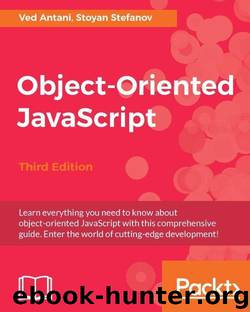Object-Oriented JavaScript - Third Edition by Antani Ved & Stefanov Stoyan

Author:Antani, Ved & Stefanov, Stoyan [Antani, Ved]
Language: eng
Format: azw3, epub
Publisher: Packt Publishing
Published: 2017-01-12T05:00:00+00:00
Using object() method
Based on the idea that objects inherit from objects, Douglas Crockford advocates the use of an object() function that accepts an object and returns a new one that has the parent as a prototype:
function object(o) { function F() {} F.prototype = o; return new F(); }
If you need access to an uber property, you can modify the object() function as follows:
function object(o) { var n; function F() {} F.prototype = o; n = new F(); n.uber = o; return n; }
Using this function is the same as using extendCopy(), you take an object such as twoDee, create a new object from it, and then proceed to augmenting the new object:
var triangle = object(twoDee); triangle.name = 'Triangle'; triangle.getArea = function () { return this.side * this.height / 2; };
The new triangle still behaves the same way:
>triangle.toString(); "Shape, 2D shape, Triangle"
This pattern is also referred to as prototypal inheritance, because you use a parent object as the prototype of a child object. It's also adopted and built upon in ES5 and called Object.create(). Here is an example:
>var square = Object.create(triangle);
Download
Object-Oriented JavaScript - Third Edition by Antani Ved & Stefanov Stoyan.epub
This site does not store any files on its server. We only index and link to content provided by other sites. Please contact the content providers to delete copyright contents if any and email us, we'll remove relevant links or contents immediately.
The Mikado Method by Ola Ellnestam Daniel Brolund(20604)
Hello! Python by Anthony Briggs(19899)
Secrets of the JavaScript Ninja by John Resig Bear Bibeault(18208)
Dependency Injection in .NET by Mark Seemann(18109)
The Well-Grounded Java Developer by Benjamin J. Evans Martijn Verburg(17575)
Kotlin in Action by Dmitry Jemerov(17185)
Sass and Compass in Action by Wynn Netherland Nathan Weizenbaum Chris Eppstein Brandon Mathis(13266)
Secrets of the JavaScript Ninja by John Resig & Bear Bibeault(11382)
Jquery UI in Action : Master the concepts Of Jquery UI: A Step By Step Approach by ANMOL GOYAL(9389)
Svelte with Test-Driven Development by Daniel Irvine(8139)
Test-Driven Development with PHP 8 by Rainier Sarabia(7889)
Layered Design for Ruby on Rails Applications by Dementyev Vladimir;(7707)
Web Development with Django by Ben Shaw Saurabh Badhwar(7216)
React Application Architecture for Production by Alan Alickovic(6899)
Software Architecture for Web Developers by Mihaela Roxana Ghidersa(4981)
Audition by Ryu Murakami(4890)
Accelerating Server-Side Development with Fastify by Manuel Spigolon Maksim Sinik & Matteo Collina(4838)
Solidity Programming Essentials by Ritesh Modi(4567)
Build Your Own Web Framework in Elixir by Aditya Iyengar(4439)
